This review was completed using a copy of Battletome: Beasts of Chaos given to us free by Games Workshop.
The Beasts of Chaos Battletome is finally here! First released in Age of Sigmar early in 2nd Edition (Sep 2018), the Children of Chaos have gone from janky MSU, to hordes of ablative wounds holding objectives, to Herdstone empowered can openers with a more recent White Dwarf release (Feb 2022). Beastlords everywhere have been patiently waiting for a new Battletome and this one changes a lot about the faction.
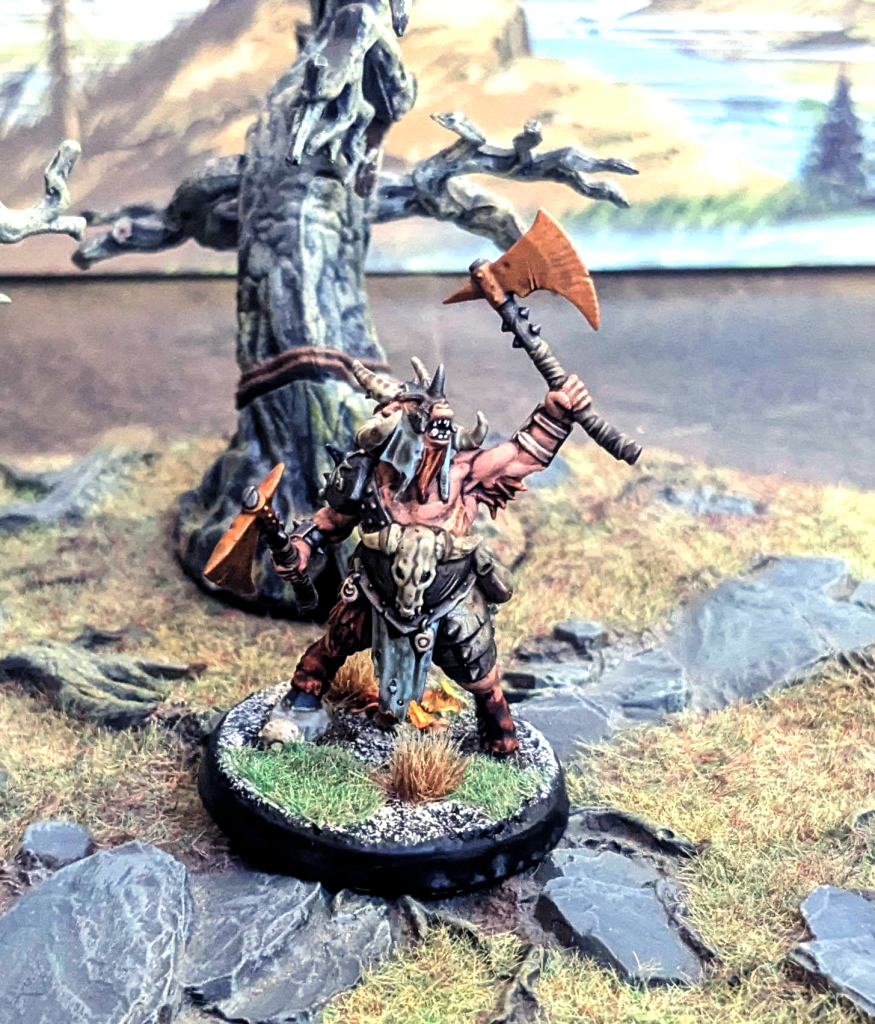
Table of Contents
Why Beasts of Chaos?
Play BoC if you love goats, you’re an anarchist, or you’re just a fan of the beastman fantasy archetype. They have always been able to ambush people – jumping out of the forest and surprising your enemy – but this new Battletome allows you to do that with your entire army.
While the BoC model line is rather aged, they’re well loved and look great on the table in huge groups. The line itself is extremely varied – you can have goat line infantry guys, big bullgor guys, or action figure sized dragon ogors, plus a huge number of monsters. No two BoC lists are going to look alike.
Top 5 Things About the Tome
- Bestigors have two wounds – They’ve always been great, and now they’re even better. They hit harder and respond to your enemy’s use of Command Abilities near them. They did go up in points but in this Goat’s opinion it’s all worth it. They match nicely with a Beastlord nearby for extra shenanigans.
- Toolbox – BOC have always been a glass cannon – and that may still be true, but the Children of Chaos now have access to a lot more defensive tech that’ll help you keep your billies alive. Whether it is shutting down enemy Command Abilities, healing after combat, adjusting enemy hit and wound rolls, or straight up running from combat, the beasts should be more survivable going forward, and that’s a huge change. There are also force multipliers – spells and abilities in this tome that make your beasts hit harder or control the battlefield better.
- We are going from being a chaff board control army with rend stapled on late to a toolbox and diverse army. The points increases attributed with that and overall 3.0 points are present to match. Beastlords who are used to a ton of models on the board will have something new to look at.
- Force multipliers – there are spells and abilities in this tome that make your beasts hit harder or control the battlefield better – there is a lot more strategy to the army now.
- Ambush – going back to WHFB, the herd have always been ambushing. In the previous tome you could leave up to half of your Brayherd (the goat guys) units off the board. In this new Tome you can leave your entire army (including monsters, bullgors, and dragon ogors) off the board if you wish, and they come on in the first two turns.
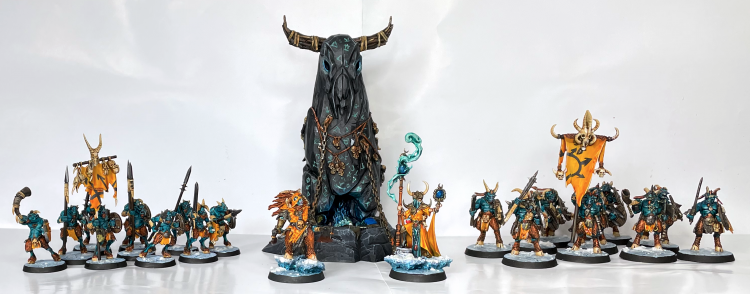
The Rules
Battle Traits
One of the biggest changes for herd generals will be Primordial Call Summoning going away. It was fun while it lasted, but to be honest with the other changes to the faction I don’t think I’ll miss it. Compared to the other chaos factions, the summoning mechanic was more disjointed. Tzeentch likes it when spells are cast, Khorne likes it when stuff dies. Meanwhile, beasts were given points for different seemingly disconnected actions. While bashing the skulls of weaker Ungors as tribute certainly felt flavorful, the idea they all stood in a queue waiting their turn was a bit goofy. It’s a big hit if you liked a big summoning army but it hasn’t been replaced with nothing.
We still have Ambush, and the Greatfrays are still there but they are much changed and more streamlined, similar to the other 3rd Edition AOS Battletomes.
Beastherd Ambush
Simply put, you can now setup every unit in Ambush as a reserve unit. It’s not limited to Brayherd only. Bullgors and Dragon Ogors, monsters etc. can all use it. Further, it’s not limited to half of your units, and you come on the board up to 9” away from a board edge, not 6”. Ambush became a lot better and we’ll likely see some null deploy strategies with BoC armies. As long as the models are on the board in turn one or two then they’re good. The only thing to remember is you’re not scoring points if you’re not holding objectives, and you will leave your back end undefended, which can make deploying in coherency with your auras more difficult.
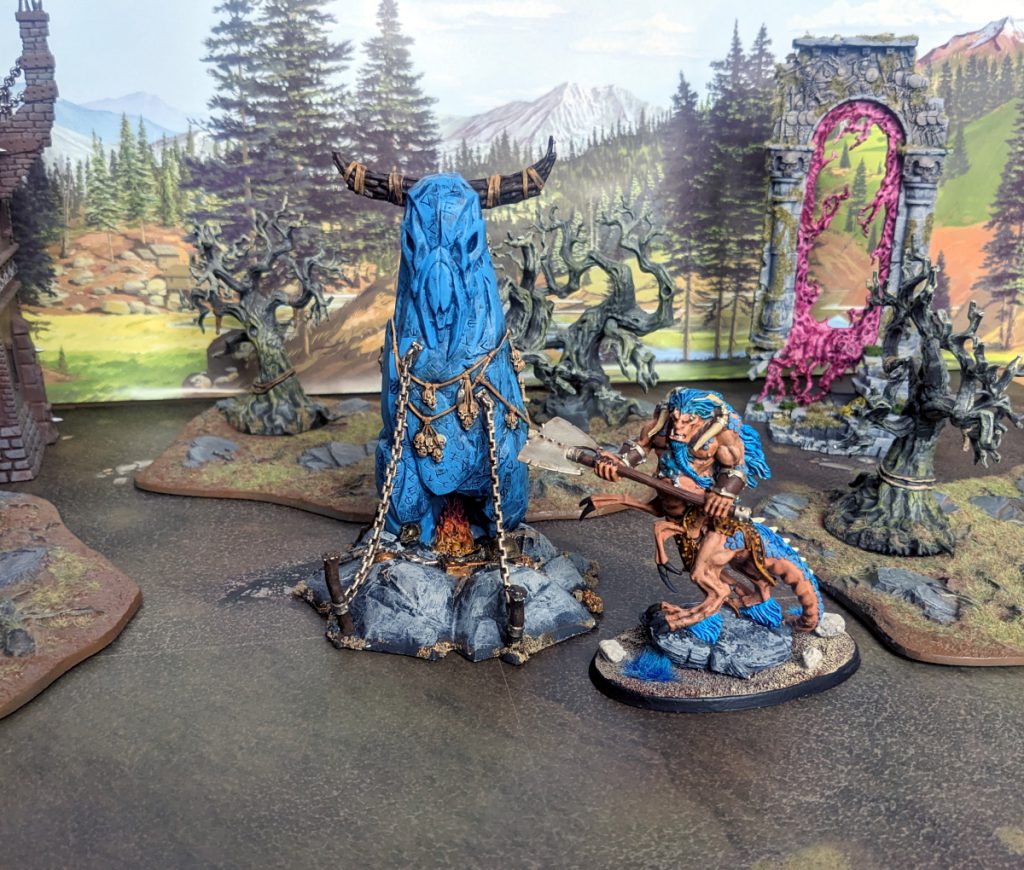
Masters of the Wilderness
This rule simply makes it so if your General is off the board in reserve, you still get a command point during your Hero Phase, basically as if they were on the battlefield like normal. This does not however give them any other benefits like using Heroic Actions or warscroll abilities unless otherwise stated.
Rituals of Ruin
The Core Rules give one Hero the opportunity to do a Heroic Action per Hero Phase. Rituals of Ruin are special Heroic Actions that each BOC Hero can do during the BOC player’s Hero phase (you can do one normal Heroic Action from the Core Rules, then each Hero can do one Ritual of Ruin as well – you can’t use the same Ritual twice, however). Additionally, one Hero in reserve can even do a Ritual of Ruin Heroic Action, treating the board edge as the location to measure from to affect enemies. Interestingly, this doesn’t work for actions that target friendly units. You gotta get on the field for that.
When a Hero does a Ritual they must take D3 mortal wounds or assign it to a BOC unit within 3” before the action goes off (again, naturally, if you’re off the board you can’t delegate wounds elsewhere). If the Hero kills themselves in the process, it doesn’t work.
Warping Curse allows you to do D6 mortal wounds to an enemy unit within 12″. Interesting, since it could in theory do more damage to you than it does to them, but you can snipe that problematic hero who hung on with 1 wound last turn, even if you’re gonna go down with them.
Blood Taunt is one of my favorites. A unit within 12” of the Hero must move 2D6” toward the unit but stay 3” away. Basically it’s the old Devolve spell from the Bray Shaman, but as an action that can’t fail. This is good tech to pull units off an objective or bring them close so you can gang up on them, possibly pulling them out of command or aura range.
Brand of Wild Fury allows you to target a BOC hero (including themselves) within 12″ and a BOC units wholly within 12” of that Hero get a 6+ Ward. 6+ Wards aren’t the best but you take what you can get sometimes.
Finally, Alphabeast Instinct allows you to select a unit within 12″ and allow them to skip battleshock tests. This is deceptively useful because the number of ways to block Inspiring Presence has gone up in the past year and this gets around this by skipping the battleshock test entirely. The problem, of course, is that in the hero phase you need to select this well before combat begins. It also only lasts for this turn, so it won’t help if your opponent gets to follow up after you. It’s going to be most useful before a dicey combat where you figure you’ll lose a lot of guys, or to keep the chaff from fleeing, so the enemy has to stay in combat with them a turn longer.
While points for all BOC heroes have gone up, I do think these Rituals might make BOC generals think about taking more heroes overall so they can take advantage of them.
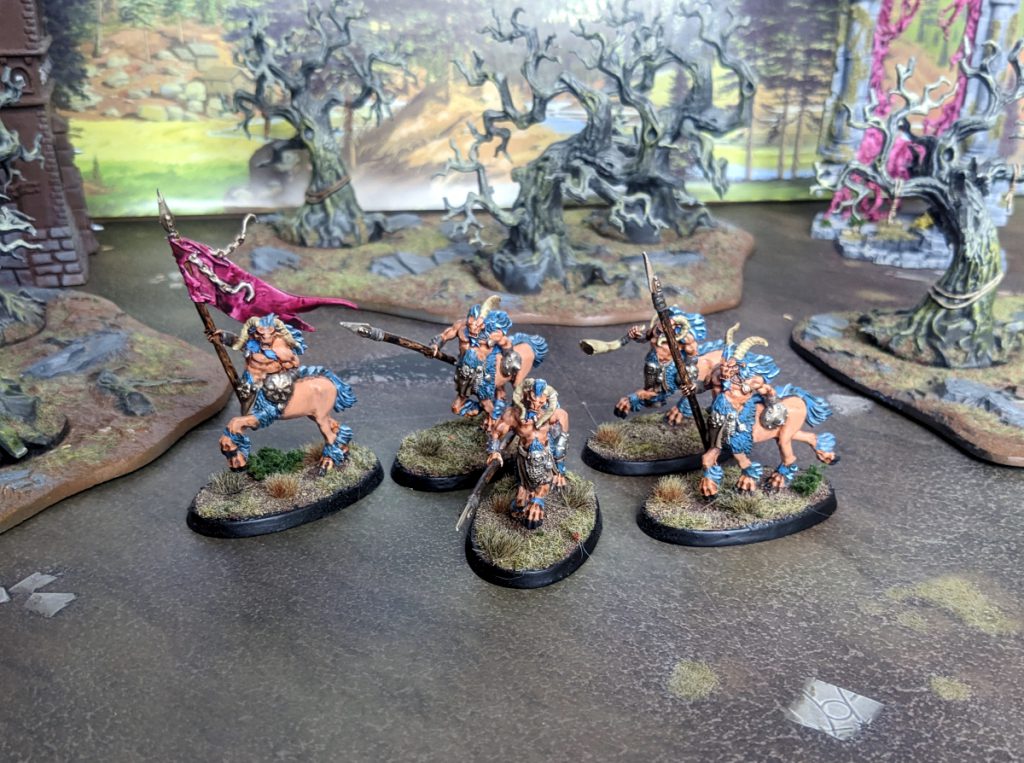
Command Traits
Command traits have been consolidated to 6 that are universal across the army, instead of having to do keyword bingo. While some may bemoan the lack of options, I’d argue it’s easier to read and makes it simpler to get going. In addition, out of the six traits, I really only think one is not going to see much use.
When your units Ambush onto the board, they start 9” away from enemies and get a +1 to your roll to charge. Bestial Cunning allows the Hero to choose one unit in reserve after deployment to start 7” away from enemies. One of the best of the bunch if you have one very strong unit you’re relying on as 7″ pushes charges into “more likely than not” territory. The Rituals mentioned above are new and provide an additional layer of strategy for Generals – Propagator of Ruin allows you to do a second Heroic Action with the General without taking mortal wounds. Not great, it’s rare you’ll truly need to do 2 with one character, unless you’re running slim on heroes.
Skullfray Gorehorn (the names of these traits are amazing btw) might be my favorite. While your Hero is within 3” of an enemy, friendly BOC Brayherds (gors, ungors, bestigors, slaangors, and tzaangors, basically) add 1 to the Attacks of their melee weapons while wholly within 12”. Beastlords are already incentivized to be near a hammer unit (more on that later) with force multipliers and this one helps even more. I also really love Twistfray Cursebeast. This trait adds the current turn number to casting rolls – even a +1 in the first turn is great! This one also is easier to use than the Gorehorn trait, as its just a passive bonus.
Slakefray Reveller helps out with speed if you wish by adding 3” to the move of BOC units within 6” of a terrain piece. Unfortunately, Beasts lost a lot of their movement buffs in the transistion to the new book, so this is arguably a very useful trait for trying to make up for some of those lost buffs. Rotfray Plaguepelt is the one I really don’t care for that much – on a 2+ in the combat phase enemies within 3” of your general take D3 mortal wounds. The battletome has a lot of ways to do D3 mortal wounds, so maybe you go all in on that, but it seems rather generic to me but it’s hard to argue with more free Mortal wounds, especially on a unit with a sufficiently large base to tap multiple units.
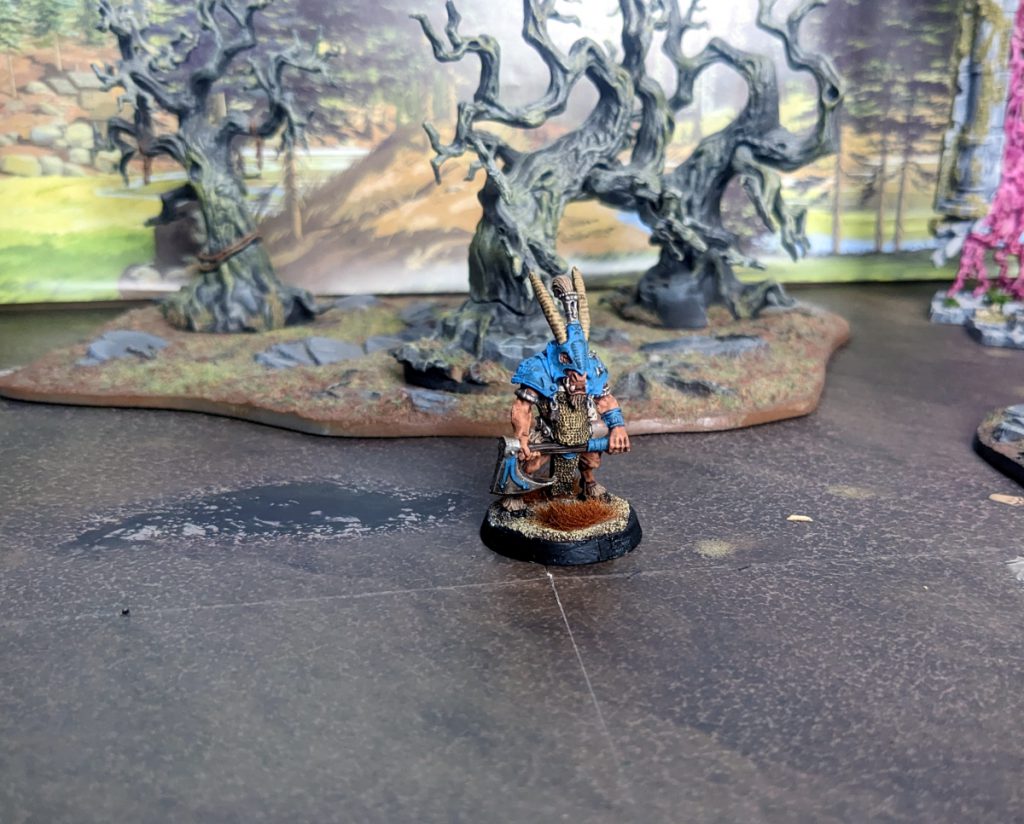
Artefacts of Power
While the Command Traits seem very useful, the Artefacts are less inspiring. As you may have guessed, I really like defensive tech. Slitherwrack Helm allows the Hero to choose a unit within 1” after a charge move to strike last on a 2+. I really like this as another way to let your billies do damage before the enemy gets to, protecting your goats. While we lost summoning, Brayblast Trumpet allows you to bring one unit of Gors, Ungors, or Ungor Raiders from the battlefield edge once per game. I could see using this for objective grabbing but this just doesn’t seem that impressive.
The Knowing Eye gives Heroes some real flexibility – if you take the first turn in a battle round, you get a CP that Hero must use to give a command. If you take the second round, the Hero gets to move 6” after receiving CP. As a player who regularly finds myself leaving a spellcaster just out of range, or my Hero is too far to provide a key ability, this one really makes me think. You can bamf your wizard into range for a spell when it’s your turn, just be careful with threat ranges.For the more combat-oriented heroes, the Axe of Morghur makes it so enemies cannot take a Ward save from one of their melee weapons. I don’t see it being hugely useful.
Beasts have always had abilities that mess around with terrain – and the Bleating Gnarlstaff causes D3 mortal wounds (on a 2+) to enemy units within 6” of an objective or terrain feature that is within 6” of the Hero. I think there are a lot of ways to stack up mortal wounds, so maybe this will feature in a strategy there – but it does require you to be very close to the enemy. Last, and maybe least for me, is the Blackened Talisman of Chaos – you get to ignore the effects of a spell or prayer on a 4+ for that Hero. Maybe I’m more used to 40k relics being huge game changers or force multipliers, but this just doesn’t seem to measure up.
The Slitherwrack Helm is the one I’ll be trying first, as I plan to use a Beastlord that gets into combat with Gors and Bestigors.
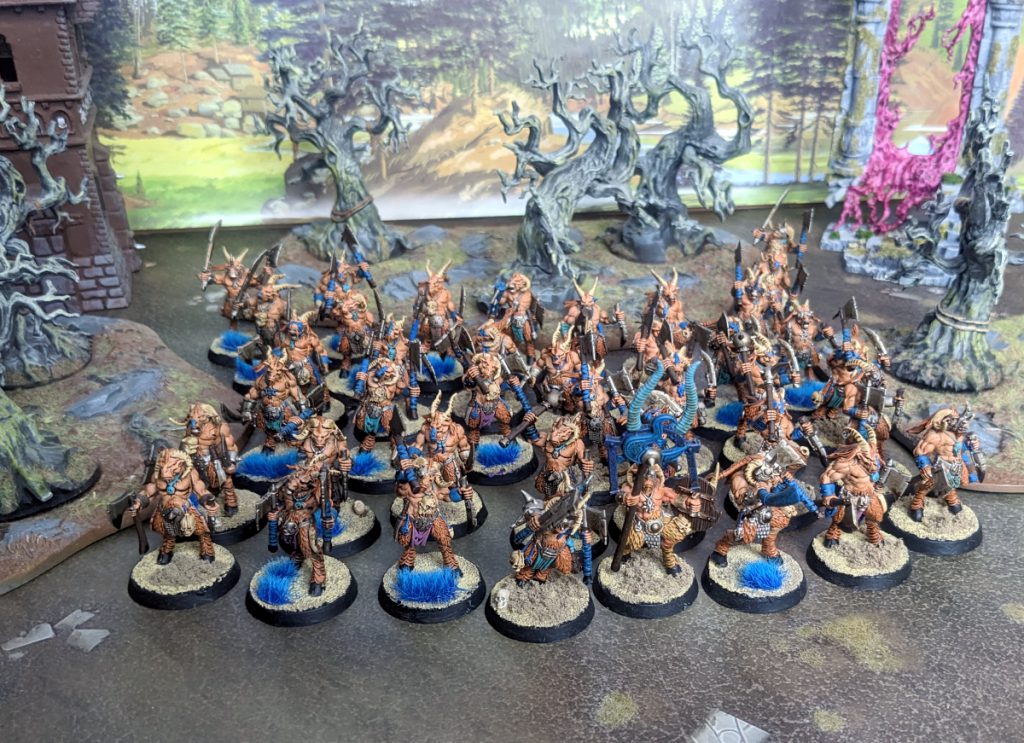
Spell Lores
Like the previous book, we get 2 lores. One for Brayherd and one for Thunderscorn.
Lore of the Twisted Wilds
The Brayherd still has their own lore and it doesn’t disappoint. The first three are less appealing to me, while the last three seem very powerful. Viletide is 12” range and cast on a 6 – it does D3 mortal wounds and the enemy unit can’t receive commands until the end of the turn. While that seems great, and goes along with our defensive tech we’ve been talking about, there are other ways to shut down commands. Similarly, Vicious Stranglethorns is 18” range and cast on a 5 – one enemy unit cannot make pile-in moves until your next hero phase (Viletide is end of turn, Vicious Stranglethorns goes until your next hero phase, which is interesting). Shamans have a connection with other monsters and Primal Dominance is 18” range, cast on a 5 – until the next hero phase, the monster only counts as one model for objective contesting and can’t do monstrous rampages. This might save your Herdstone from a smash but still doesn’t measure up to the others in my view.
Then we get to the offensive output buffs – I really like these and can’t choose a favorite. Tendrils of Apathy targets an enemy unit within 12”, cast on a 7, and you add 1 to the damage of any melee attacks made against it until your next hero phase. I really like this because you don’t have to choose one friendly unit to get +1D, you can send multiple units in to take down a big target. I also like that it goes until the next hero phase – so if your guys are still alive in their turn they get to hammer again. 7 casts can be hard as a BOC wizard, but we have the Twistfray Cursebeast trait that adds the turn number to our casting rolls so it should be easier to cast.
Another 7 cast spell is cast on a friendly unit wholly within 12” – Wild Rampage gives your goats exploding 6s on hit rolls and lasts until your next hero phase. Another force multiplier that helps us hopefully delete units. The last spell in the list, Titanic Fury, gives a friendly Monster within 12” +1A on all their melee weapons, and is cast on a 6. This is cool if you’re using Monsters – I can think of one later on that I would definitely try this on.
Overall, I rate Tendrils of Apathy and Wild Rampage as the two that I’d like to use the most right now.

Lore of Dark Storms
Shaggoths now get five different spells to choose from, up from three in the past. Hailstorm retains its awesome anti-movement capabilities, at cast 6, 21” range – it halves movement, run and charge rolls. This is unchanged from the previous book. I love the 21” range – it keeps you out of melee threat and keeps the enemy away. Another defensive tech spell (sensing a theme?) Fulgurous Blades is a 6 cast 18” range (love the huge range on these spells!) that selects a friendly unit wholly within range. Enemy units subtract 1 from the Attacks of their melee weapons – I love this because it helps keep our goats alive. It doesn’t even have to be only on Dragon Ogors, either.
Thunder Wave is a cast 5 range 3” D3 mortal wound spell. Furious Gale is cast 6, 18” range, subtract 1 from the Attacks of enemy missile weapons. This is enemy units within 18”, not wholly within, so you could hit multiples of them if you have a central location for your Shaggoth or if he comes on from Ambush in the back. I love this.
Raging Storm is interesting – its cast on an 8, range is board wide, and every Thunderscorn unit heals 1 while every enemy unit suffers 1 mortal wound. This would be funny to soften up enemies, especially characters, and if you cast it a few times it could be very annoying.
Overall, I love the range of the Dark Storms spells, and I like the lower casting values. I think I’ll likely try out Furious Gale and Fulgurous Blades first, as those help to keep our dudes alive.

Greatfrays
Allherd used to be the go-to if you wanted to summon stuff because you’d get extra Primordial Call points. Instead, you get to bring back slain D3+3 Gors, Ungors, or Ungor Raiders each Battleshock phase. In the past I might not think this is a great trait because the unit would just get wiped anyway – this is one of the ‘defensive techs’ I talked about above. I think if you use your units less as MSU and more as bigger units, you can keep them alive better with rally + bringing them back with Allherd. Notably, this does not affect Bestigors.
Darkwalkers allows you to remove one unit of Gors, Ungors, or Raiders and place it back on the board anywhere 9” from enemy troops and 9” from a board edge. I could definitely see this being used to hunt objectives or setup long charges.
If you like Chaos Spawn, as many Beastlords did with the 2nd Edition tome because Gavespawn had some cool benefits, you can actually take them as battleline in this Greatfray. The Morghurite Chaos Spawn are different from what we’re used to – they have a ranged attack that is decent and they actually subtract 1 from enemy melee attacks while within 3” of an enemy unit. Again, this is the defensive tech I talked about above.
The much-maligned Cygor gets a buff in the Quakefray, a new Greatfray for this Battletome. Cygors become Priests, the only Priest that BoC have access to. Their prayer does mortal wounds to objective holding units and makes it harder for them to hold said objective.
Of the four, I will likely be trying out Allherd first, because I plan on bringing plenty of Gors. Gavespawn and Quakefray both give us new options that are really interesting and will definitely be worth trying out. Beasts are no longer locked into certain command traits or artefacts based on Greatfray choice, so picking one is not a negative, so to speak.

Grand Strategies
There are four Grand Strategies – up from just the one we had in the White Dwarf update. Protect the Herdstone stays virtually the same – nobody within 9” of your Herdstone, and it can’t be destroyed. It’s something you want to do anyway, so it seems like a great choice. Descrating Brayherd requires you to end the battle controlling 2 or more objectives and they are contested by friendly Brayherd units (Gors, Ungors, Bestigors, etc). This would be my backup choice.
The other two seem like they’d be harder to pull off – one requires you to go against the nature of the units, and the other is just difficult. Flanking Warherd requires you to have 2 or more Wareherd units within 9” of the battlefield edge. Warherd units are bullgors, gorebulls, ghorgons, and cygors. These units generally want to tear up the enemy units in the middle of the field – I don’t see them hanging out near the edge. The other, The Age of the Beast, requires that you have 2 or more Cygors or Ghorgons on the battlefield and none of them have more than half their wounds allocated to them. While both of these units can heal during the game, they’re 5+ save 16 wound models – I don’t see it happening.
I will definitely be trying out Protect the Herdstone first and seeing how that goes.
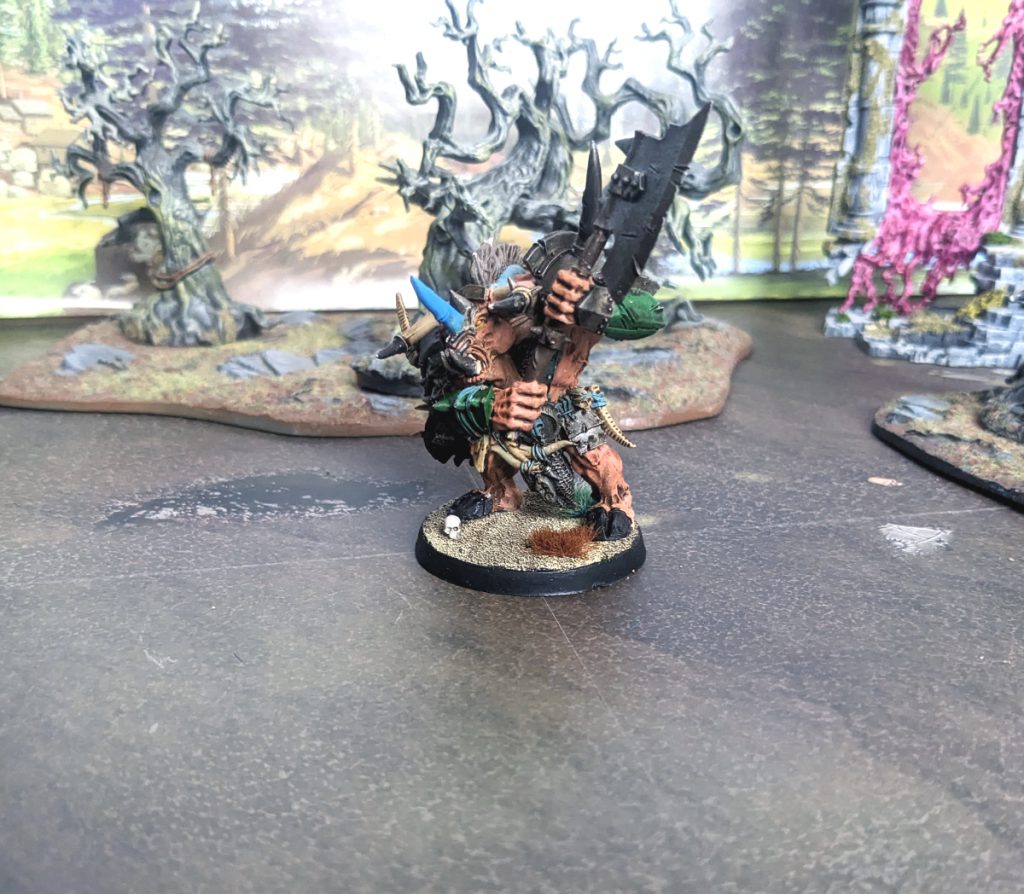
Battle Tactics
There are six battle tactics now, up from three in the White Dwarf update. In The Shadow of the Herdstone has changed just a bit – it now has a range of 12” of the Herdstone, which is nice – you’ll likely want to protect the Herdstone anyway for your grand strat, so taking out enemy units near it is a no brainer. Bestial Wrath is a little more situational – you complete it if your general and 2 or more units are within 3” of any enemy units, and it can only be picked in the first or second turn. If you’re already engaged in turn two I suppose you could pick it and attempt to score it that way.
Two of the tactics are based on positioning. Rampaging Beastherd requires you to pick one objective controlled by your opponent that you then control at the end of your turn with 10 or more models. Ambushing units could definitely help to get this one if you charge them and destroy their unit, or just move onto an unoccupied one. Aid of the Wilderness is completed if 2 or more units are in cover wholly outside of your territory. I like this one a lot because it’s very thematic and seems like it won’t be terribly hard to complete.
The last two are contingent on destroying units – Trampled To Mulch has an amazing name but requires you to kill a unit during the charge phase with mortal wounds. While we have a few ways of doing that, I don’t think it’s very predictable. Reduced to Savagery is completed if you pick a unit as the target of a Ritual of Ruin (so either Warping Curse, doing D6 mortal wounds, or Blood Taunt, making the enemy move 2D6” towards the Hero) and then destroy it in the same turn. This one is easier to complete, in my opinion, as you’ll be able to pick your fight and use ranged attacks as well.
The ones I am going to try out first are In the Shadow of the Herdstone, Rampaging Beastherd, and Aid of the Wilderness.
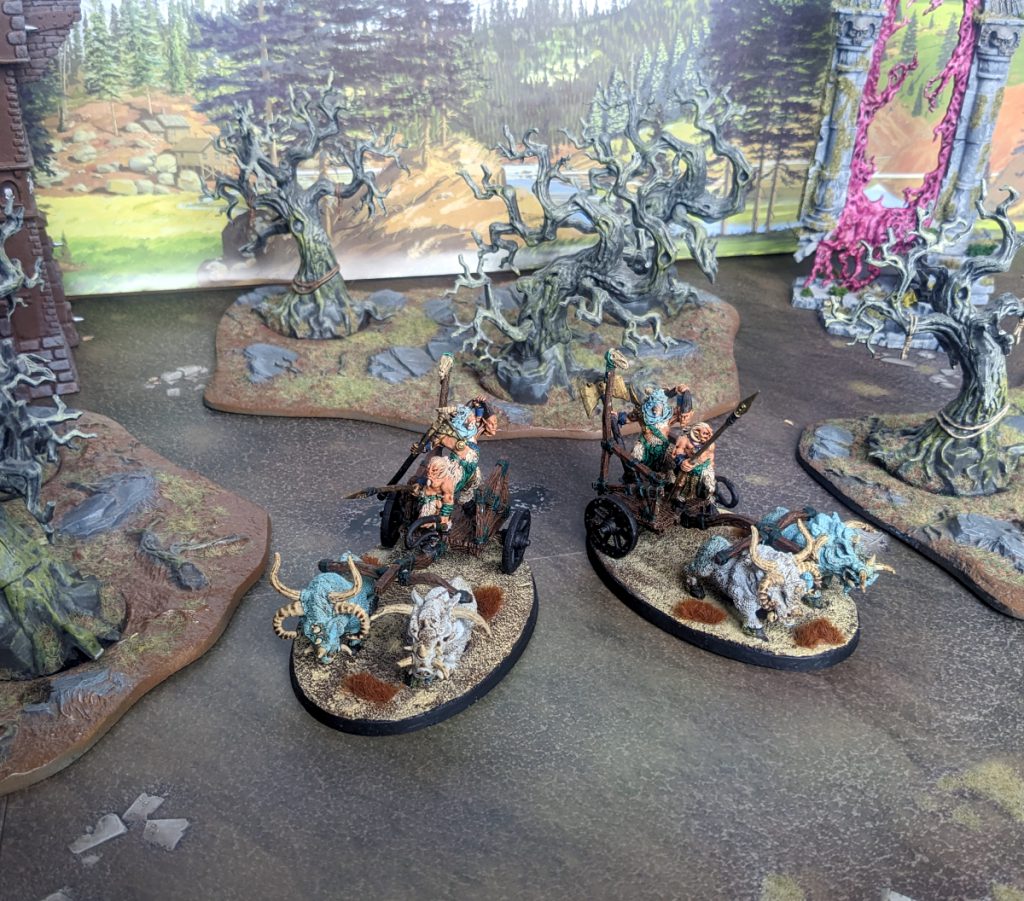
Units
Heroes
Beastlord
One of my favorite choices since I started playing Beasts in 7th edition WHFB – the Beastlord is back, billies. The new model looks great and the rules will live up to it. He gains a wound, while losing one attack – however his axes are now D2. He does more damage overall – the old staple of the Gavespawn artefact plus re-rolling 1s to hit has been gone for a bit now, and instead he gets 6s to hit do 2 MWs.
He helps friendly units if he’s near enemy heroes – they get +1 to hit and wound, which is great. You want him basically running forward with a unit of Bestigors as his vanguard because he also can grant one unit the ability to fight right after him (or right before him). I really love the theme here – he’s not just running off to fight stuff, he’s got his lads with him to take out the center of the enemy line.
Along with this new utility and survivability, the Beastlord goes up by 40%, something that will be a theme with this new book – something we’re not used to if you’ve been playing BoC for a bit. Goats cost more in this economy. Interestingly, the Beastlord has no built-in Command Ability. I would definitely consider the Slitherwrack Helm for the Beastlord so they can make enemies fight last, then beat the bleats out of them. Skullfray Gorehorn adds to the attack of your Brayherds,and you want them near him anyway, so I’d definitely consider that.
Great Bray-Shaman
The GBS gets worse overall in combat – his save is now a 6+ and his staff attacks are worse. He still only casts and dispels one spell per turn. He also lost the movement buff that he gave to Brayherd units. Shamans have better range on their Rituals of Ruin – they add 6” to that. This is a nice subtle trait here – you can do D6 MW to a unit within 18”, or use Blood Taunt which replaces the old Devolve spell.
Devolve is now different – you choose an enemy unit within 18”, (cast on a 7), and before they move, run, retreat, or charge you roll 3D6 and if it’s higher than their Bravery the move is halved. I like this – another utility spell that you can use to protect your goats or backline stuff. The GBS actually goes down 5 points from current, so I expect to see these guys slinging spells all over. I would definitely consider the Twistfray Cursebeast command trait for this dude so spells are easier to cast.
Doombull
The Doombull’s core stats remain largely the same – gaining a 1D on Horns and losing a Rend on the Axe. The D3 mortals on charge are now built-in to the warscroll – I love it but I wish it was just automatic, not on a 2+. I know asking for automatic stuff is wishlist-y but it’s just annoying to have to remember to roll the dice and use up time. Bloodgreed changes a bit – you don’t get to keep rolling the attack after a 6 to hit, it just causes MW equal to the damage of the weapon, which is more in line with 3rd Edition stuff.
The Doombull’s Command Ability goes from being a +1 to Wound for another unit to allowing another unit to charge in the Command Phase. This allows you to charge without being subject to Unleash Hell, and also gives you an extra chance to make a long charge. The doombull predictably goes up in points more than 35%, so honestly I’m not sure how much we’re going to see them on the board. I’m just not sure if they’re going to match the utility we see from other leaders.
Dragon Ogor Shaggoth
Wow! The Shaggoth got some big changes. They’ve been used a ton more recently, from what I’ve seen, compared to when their Tome first got released, and I think people will be interested to see the changes. He was always a combat master and he’s even better now. He has a ranged attack now, which is great. He can consistently throw out 2-3 wounds at 12” range, something we haven’t had with our other leaders.His axe lost a damage but gained two attacks, his tail gained a damage and went to D6 attacks, and his forelimbs gained two attacks – overall a huge bonus to offensive output. Enemies take D3 MW on a 2+ when near him, so that just adds to his buzzsaw. Add to that he’s still a Monster so he can do Monstrous Rampages.
He gains some survivability in that he can cancel spell effects on himself on a 4+, and at the end of each combat phase he can heal D3 wounds on a 2+. Summon Lightning is somewhat similar to the old spell, but you get to choose D3 units instead of just one to heal up D3 wounds.
Overall, I think this unit goes from a backline guy who slings spells and holds the Herdstone to a midline hero who goes in with your goats and continues the slaughter. I would again consider the Twistfray Cursebeast trait on this guy because you want him casting spells.
The Shaggoth went up a massive 55% in points – so I’m worried if he’s going to be found in most lists. He didn’t get a massive boost in survivability, he’s still 10 wounds so he doesn’t count as a Galletian Champion and he doesn’t get Look Out Sir. He can heal during combat phases but I imagine if he’s going to die it’ll be in one go.

Beasts of Chaos Tzaangor Shaman
The Tzaangor Shaman was a staple in my lists since the Tome first came out and I was a little discouraged when he received a new Warscroll with Tzeentch and lost many of his buffs to the other Tzaan units. He really doesn’t change much from the 2.0 Battletome except he loses his buffs and the Sorcerous Elixir becomes more dependable. Boon of Mutation is still very similar. He’s actually cheaper than the current version, which is nice – he could be a more tanky spellcaster that you want (he has a 4+ save now). If units of Tzaangors (the foot version) are in your list I could definitely see taking one.
Grashrak Fellhoof
Crawling out of the Beastgrave, Grashrak has always been a staple in my lists because he had a very useful spell. He’s still got the utility (add +1 to hit versus a unit hit by his D3 mortals spell) and he actually has a 1 better save than regular GBS. He also gains the better range on Rituals of Ruin that the GBS has. He went up in points from the current version but I don’t think it’ll hurt his usability.
Battleline
Gors
There are a couple things I really love about this book – and Gors are one of them. Back in 8th Edition WHFB I painted 40 of them with two hand weapons for a big horde, and they didn’t translate well to AOS. They were practically useless if you didn’t use them with shields and I wasn’t willing to remodel them. I’m glad I waited, because they went from 1 attack, hitting and wounding on 4s, rerolling 1s to hit, to 3 attacks, hitting on 4s, wounding on 3s. I love that they’re back to being insane guys running across the board ready to rip and tear. Shields still give a bonus +1 save, but they’re not for me.
Possibly more importantly, Gors stampede into enemy units and cause them to be disrupted – on a 3+ you can pick one enemy unit within 1” to fight last. I love the utility and added survivability here. We lose access to running and charging, but we still get a bonus to run and charge from the musicians, and we rally on a 5+ instead of a 6+. They go from 7 points a model to 11, but I feel the changes warrant it. I really like the idea of a 20 blob running in and making enemies fight last so they can survive to destroy. They’re more likely to stick around with a higher bravery of 6, and more likely to rally, so the bigger blob might be helpful. If you use Allherd you can even get back D3+3 each battleshock phase – pretty sweet.
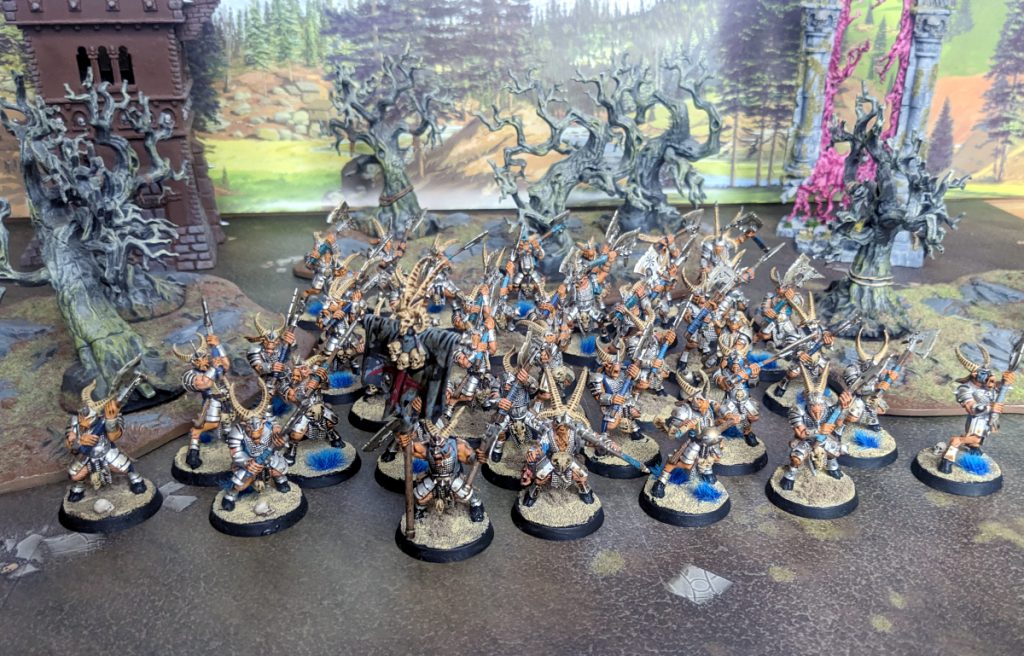
Bestigors
All I can say is: two wounds! Our closest thing to heavy infantry get a big survivability increase with two wounds and a move up to seven bravery. Added to this you get the standard bearer bonus of rally on a 5+, and our dudes will be less about hitting stuff and exploding and more about damaging and maybe sticking around. They also hit better, at 3+ instead of 4+, so they’re truly elite infantry. The range of their attacks goes up to 2”, a massive upgrade!
They’ve also gained some cool anti-orders tech – when a unit within” recevies All-out Defense, they gain 1A. When a unit shoots them with Unleash Hell, it’s -1 to wound. Super interesting and helps them get there! They go from 12.5 ppm to 22 ppm, which is sound in my book. I think a solid block of 20 that helps you stick around to rally back dudes will be essential. They’re also Battleline now not only from having a Beastlord General, but also a Great Bray Shaman, which is nice.
Ungors
With our 2.0 tome, Ungors were basically a no-brainer as objective takers and screeners – they were cheaper than Gors and basically just as survivable. With this new update they gain a real differentiator – Gors are now more offensive, and Ungors are definitely more firmly in the screening business. They’re faster, at 7” movement, and can actually retreat in the combat phase when chosen to fight – a really cool mechanic that will make them take off if necessary, and maybe do some objective shenanigans. Ungors with spears actually get a ranged attack too, which is neato. Not game changing but neato.
Ungor Raiders
Raiders are actually battleline this time – for each unit of regular ungies you take, you can take one unit of raiders as battleline. I really like this – it sets you up to have different lists, not just defaulting to the same stuff every time. They lose 6” of range on their Bows but gain an additional attack – a weird trade off that we’ll have to see how it goes. A new mechanic has been introduced that allows them to shoot from off the board in Ambush, which is really neat. You can pick off archers or artillery or whatever within 12” of a board edge and be protected from reprisal. You also measure from a point on the board edge, so you don’t have to worry about all 20 raiders being within 12”, if you take a big unit.
Centigors
Centigors have always been weird to me – as centaurs they’re a fantasy staple, but they were mostly metal for a long time and then finecast, and they held a weird spot in the army. The army was already very mobile, so they just didn’t fit to me. They’re now Battleline if you take a Great Bray Shaman, and we’ve lost some mobility, so they might be nice for a splash in to take objectives.
Overall I like how their stats increased – they have one point higher in bravery, hit and wound better, and they have 8” ranged attacks with rend now. They hit harder when they’re near objectives. Their banner is different from the rally banners – this one lets them retreat and charge, so you’ll have more movement from them when you need to.
I like their special rules – before they were mostly just fast dudes that hit stuff, which you could get elsewhere – now they negate the first two wounds or mortal wounds caused to the unit in the combat phase. Load them up with Mystic Shield or All Out Defense and see them tank smaller units on the flanks, holding stuff up. For that reason I think I’d like to consider taking two units of five instead of one unit of ten – spreading out that ability and really messing around with flank objectives.
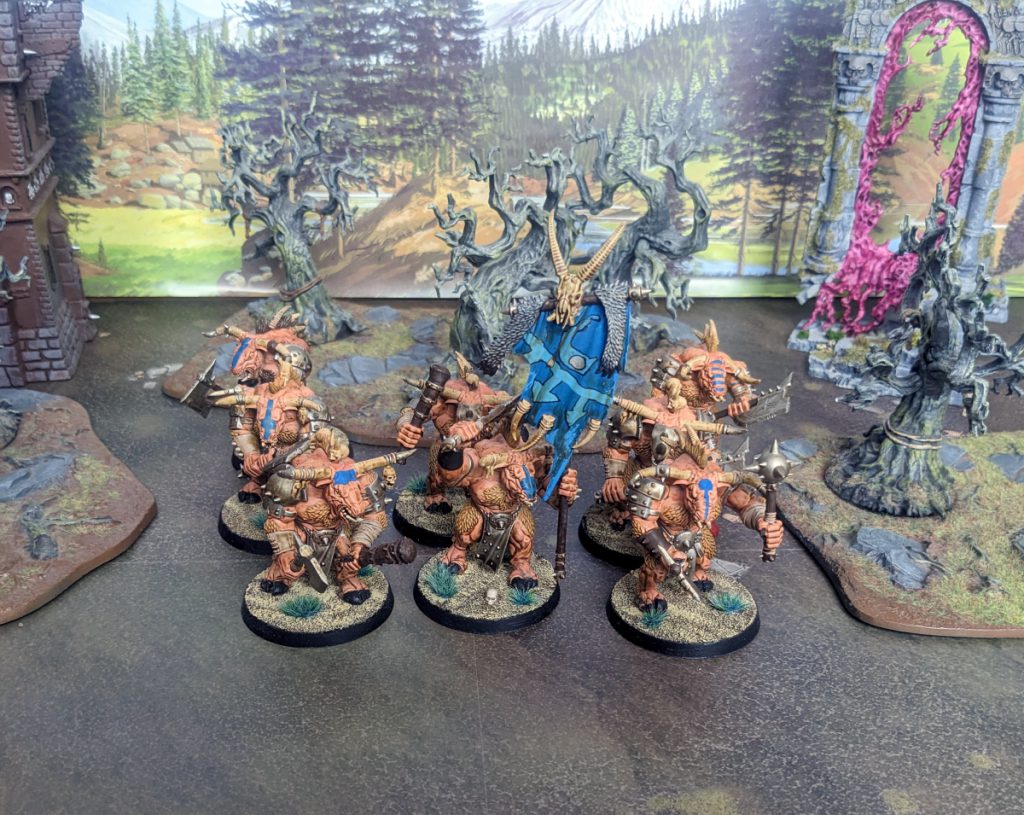
Bullgors
Every Beasts player wants these guys to be good. With the points drops and the Herdstone changes in the last few years, they’ve seen some play as blenders that run up the field in small units. For me, with no increase of armor save or wounds I am just not sure about these guys.
Their offensive output has not changed a ton, though the range of their weapons goes from 1” to 2” for all weapons, which is great. They do have a good chance of causing three mortal wounds when they charge (or six if you reinforce them). I just don’t know if they’re worth taking at a 50% increase in points. They are still battleline if you take a Doombull as your general. Maybe I’m missing something here – please leave a comment if you think I’m wrong.
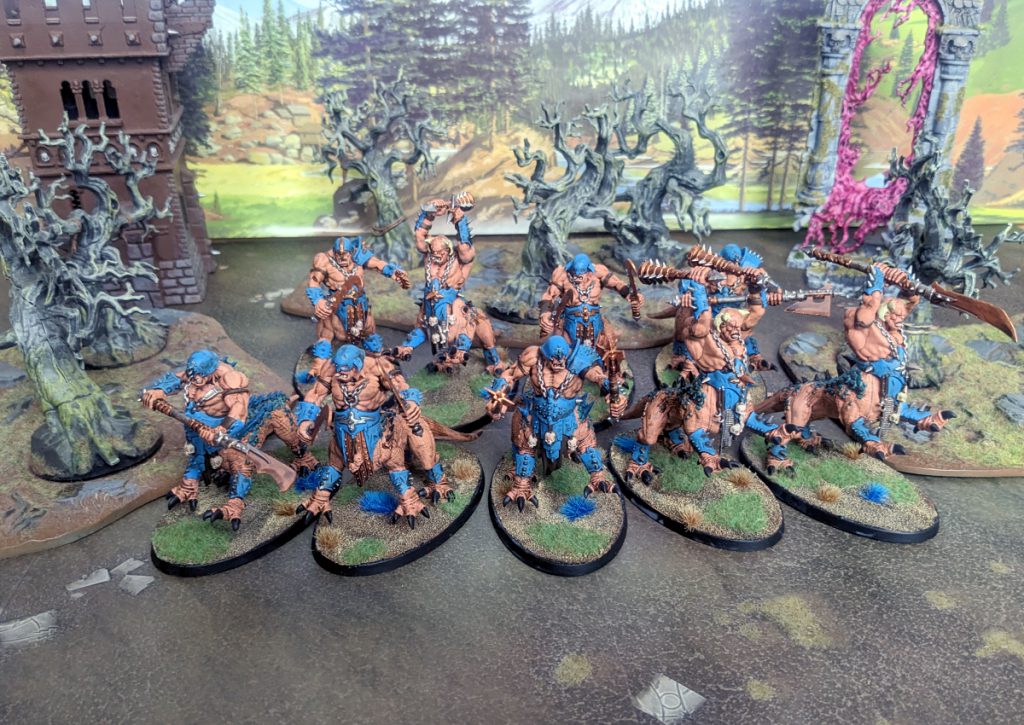
Dragon Ogors
After the White Dwarf Herdstone update and points changes, it seemed like Dragon Ogors were everywhere. They’re battleline if you take a Shaggoth as General, and they’re great minis, so I think there was definitely some will in the BOC player community to find a use for them. Like Bullgors, these guys saw a 50+% points increase. They hit better, wound better, and have more attacks. After they charge, sixes to hit auto-wound, which again is more offensive output.
If they survive to end a combat phase, they heal D3 wounds and inflict D3 mortal wounds on nearby enemies. The Shaggoth can also heal them using Summon Lightning during the Hero Phase. This makes them more survivable, for sure.
Compared to Bullgors, I think I like these guys more. They’re similar to me because they’re both larger infantry with more wounds. Dragon Ogors are tougher, with a 4+ save built-in, and one more wound each and the ability to heal back wounds. Their weapons are 2” range (except their claws).
I think with Dragon Ogors and Bullgors both we will see fewer armies entirely using them as battleline and maybe just one-off units. It helps, to me, that the Shaggoth is better than the Doombull. I might consider two units of three as flank holders because they’re fast, big bases, and can heal.
Beasts of Chaos Chaos Spawn
I think this is interesting – the beloved Chaos Spawn minis can now be battleline in a Gavespawn army. They remain largely the same from the previous tome, although now you can’t use the Gavespawn command ability to add +1A to units. They’re faster, at 3D6” instead of 2D6”, and they can run and charge, so they can shoot out and hit stuff further out. In a Gavespawn army, I think I’d rather just take the Morghurite Spawn.
Morghurite Chaos Spawn
If you’re using Gavespawn you can take a unit of three of these that then split up into single units. Theyr’e similar to spawn except they move 10” and have a guaranteed 8 attacks (regular spawn are 2D6) and hit on 3, wound on 3. Maybe more interestingly, they have a ranged attack – something that we’re short on – that does decent damage. I like that they have a special rule that subtracts one from the Attacks of weapons of enemy units within 1” – this could be a tool you use to combo with another unit into a big enemy unit.
As a new choice here, I personally rate this unit as interesting – they’re not super expensive at 75ppm, but they’re no longer a summoning target or points filler like they used to be in Gavespawn.
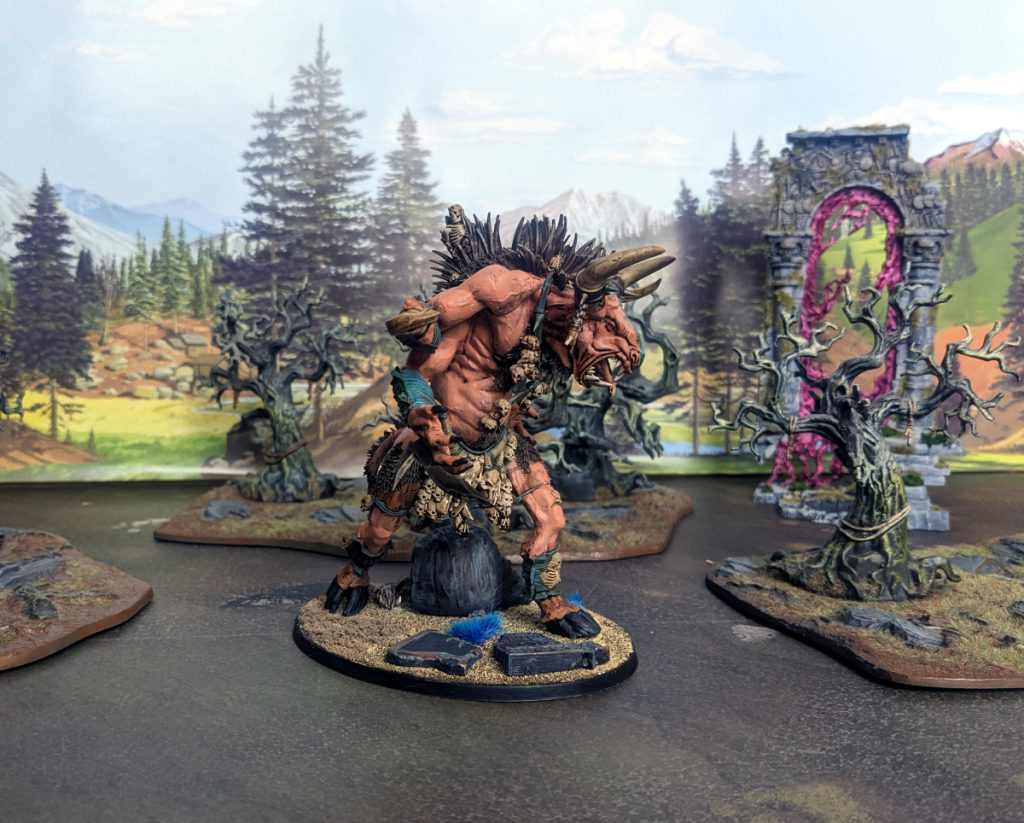
Behemoths
Ghorgon
Every BOC player has at least one of these guys as they came in the Start Collecting box. With a 55% points increase you’d hope for some really solid upgrades, but they weren’t necessarily the upgrades I wanted. Ghorgons gain two wounds but remain at a victim-stat 5+ armor save. They do have the ability to heal – you choose a number of models depending on the Damage Table, try to roll above their wounds characteristic, then destroy that model and heal wounds equal to characteristic. You can also heal up to three wounds each turn by using the Ghorgon specific Monstrous Rampage.
The offensive output of its Butchering Blades and Huge Slavering Maw is increased, with more attacks overall and more Rend using the Monstrous Rampage. I really don’t know if the increase in output and potential healing is worth the points increase, to be honest. I’m worried that they just get knocked off the board from shooting and combat before you can heal back to useful stats.
Cygor
Perhaps one of the most maligned models in the BoC bestiary, Cygors are interesting because they can now become Priests if you use the Quakefray. They’re basically a one-shot artillery and anti-wizard piece. They now hit on 3+ instead of 4+, and when at full health they do 5 damage instead of D6 – but they got their range reduced to 12” instead of 18”.
The anti-wizard tech is increased – they can still unbind 2 spells, which is nice, and each time an enemy Wizard within 30” successfully casts a spell and it’s not unbound, they take a mortal wound. That’s pretty cool and really annoying.
I love the idea of making this huge thing a Priest, and I like that it hits easier with the artillery, but I just don’t know if it’s worth the 68% points increase here, especially with the range reduction that then puts you in threat range of a lot of stuff.
Jabberslythe
Unlike the previous monsters, the Jabberslythe barely went up in points. The warscroll doesn’t show Fly currently but I feel like that’s a typo – the model has wings and has had Fly before. The White Dwarf upgrade to a 4+ save stays in this Tome and definitely helps me want to bring it to the table. The main melee attack lost rend, but I feel like maybe it’s because it can now carry out a monstrous rampage where it removes some armor save from Heroes nearby. Combine that with the 4+ mortal wound reflection with Bile Blood and Jabbies can be a hero hunter.
As a cheaper monster that is faster and can fly, I can see this guy hitting the table.
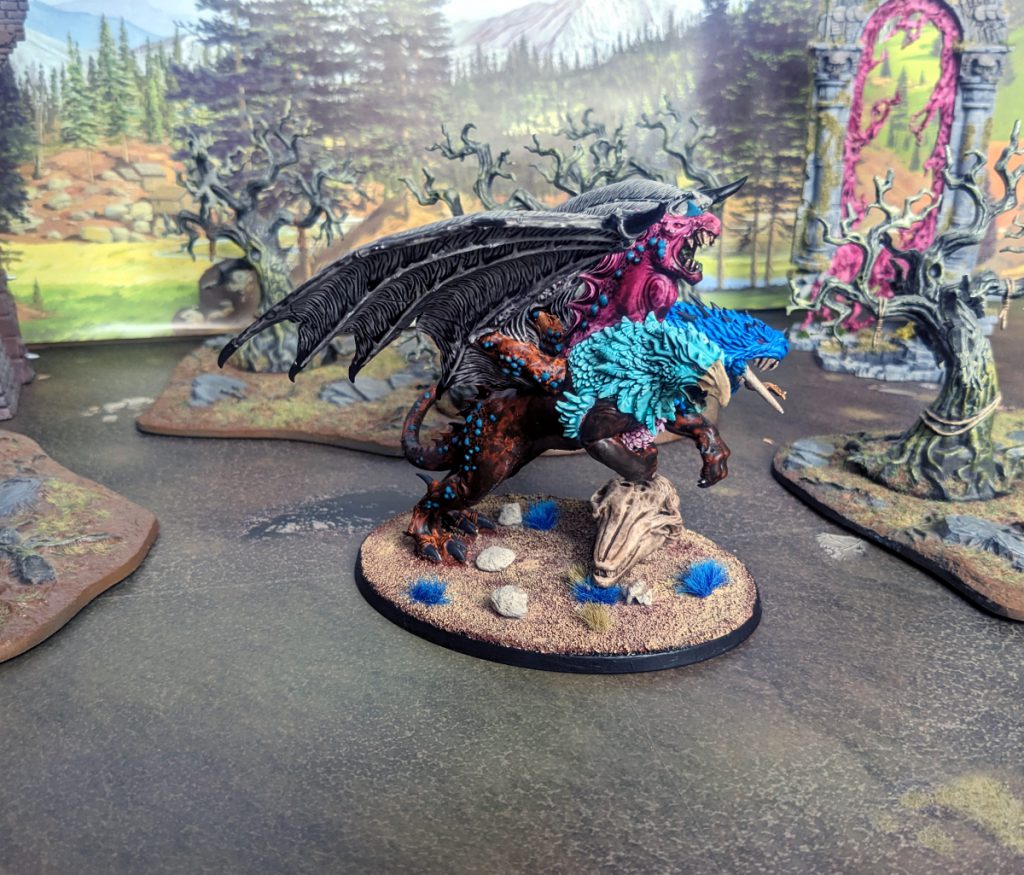
Chimera
This unit actually received a point reduction – one of few in the book to do so. Chimeras were a fun source of Summoning in the last Tome because they added two to their charge rolls, so it was easier to charge in from the board edge. They lost that ability but gained more mortal wounds on average from their Fiery Breath. They also don’t have a damage table anymore, despite keeping the same 12 wounds. Overall I like the model, and I like the offensive output especially with the monstrous rampage they have – it’s worth a try.
Chaos Gargant
The Chaos Gargant actually received points decrease as well, so it seems a little more attractive to me if I need a monster. I like that it has a smaller base so it is easier to move around. It retains the ability to remove individual enemy models to try to put guys out of coherency, and while it doesn’t have it’s own monstrous rampage it does gain +1A on every melee weapon when within 6” of friendly Heroes. I feel like the damage output will be relatively similar but you also get a multiplier here – enemy units within 3” subtract 1 from their save rolls. It is interesting to think of a unit of Gors, Beastlord, and a Gargant charging into a tough unit to try to get it de-buffed and then blown up.
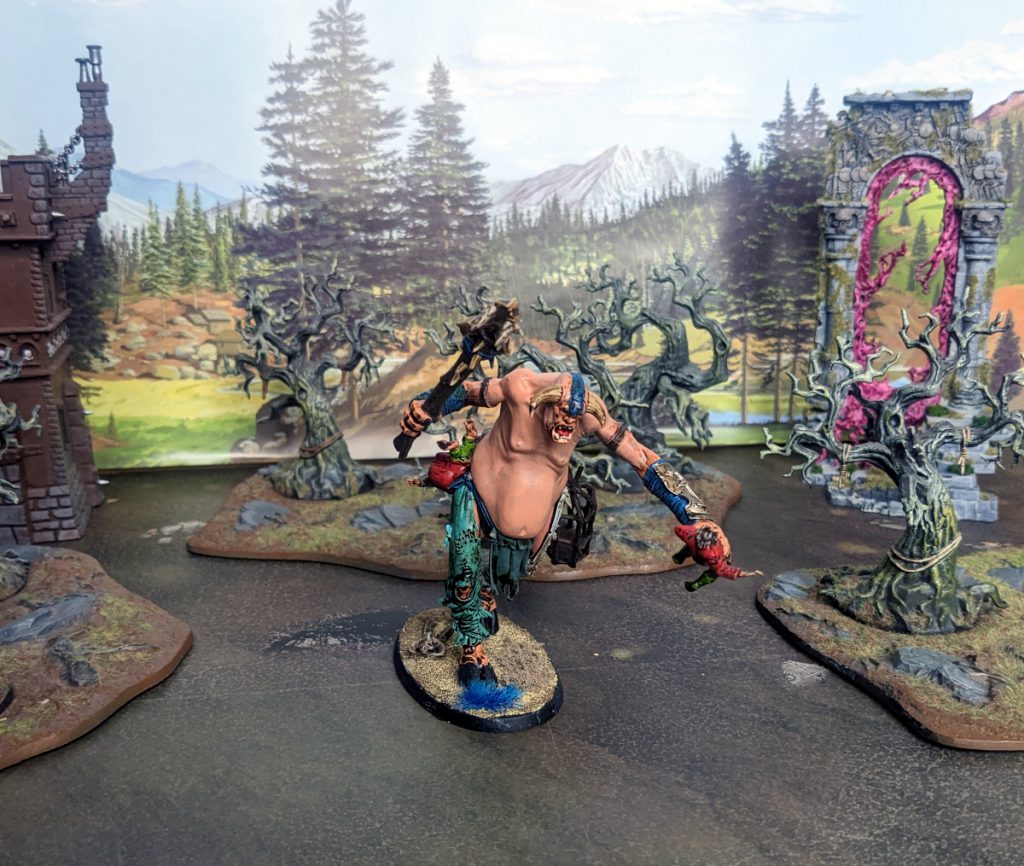
Other
Tuskgor Chariots
Chariots gained a wound and some better offensive output with the upgrades that Bestigor weapons got. They now cause Mortal Wounds when they charge – you roll a number of dice equal to the Charge roll and on a 5+ (or 4+ for smaller infantry) they take a mortal wound. They went up almost 50% in points, but I feel like they’re worth a try to see if they can do some mortals with big charges.
Razorgors
Not much has changed here – offensive output goes up a bit, and interestingly they double their attacks value if they’re within 3” of Ungors because the Ungors bait them into a frenzy. They can heal one wound per phase if enemies are slain as they eat dead bodies.
Beasts of Chaos Slaangor Fiendbloods
I think most Beastlords want these guys to be good because they’re new models – us BoC don’t get them very often. They look sweet, too. The rules are definitely better than what they were, and they only go up a bit in points, so they might be worth a look. I like the ability to fight twice once per battle, I’m just worried that with the second fight having the strike-last effect, are they going to make it to that point? They only have three wounds and a 5+ save.
Chaos Warhounds
These seem like interesting objective grabbers – they go up to two wounds from one and retain their fast movement and 6+ save. Their charge rolls are more dependable, being able to change one die to a 4. With their points staying the same they might be included to take objectives and mess around in the enemy backfield.
Cockatrice
The chicken monster stays about the same – although it loses the Monster keyword. It can fly fast and it gets a pile of attacks when it charges. Interestingly, it goes from D6 mortal wounds with it’s stare to D3, but the enemy unit only hits on 6s with melee weapons (it’s no longer a ranged attack). Another interesting combo to fly in and attack hard targets with another unit.
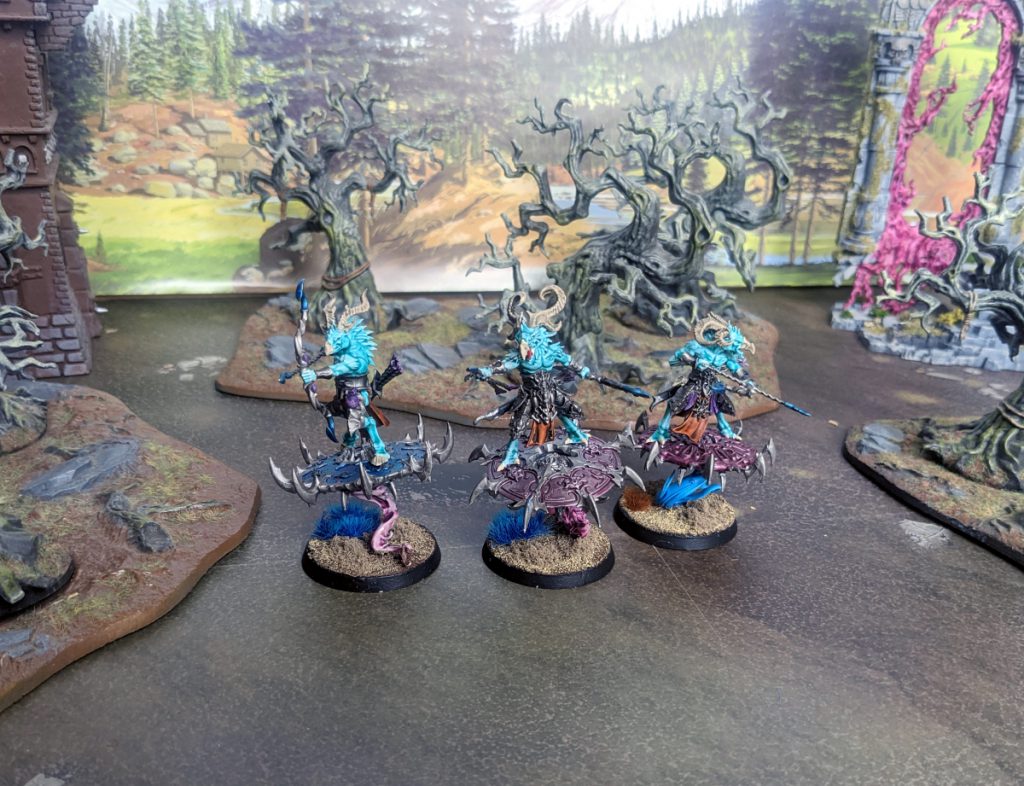
Beasts of Chaos Tzaangor Skyfires
These dudes don’t change much at all from the Tzeentch update. They’re reliable shooters from range have a 4+ save with four wounds. They’ll definitely be something I try out – especially since they no longer need the Shaman to be more useful. I like that they ignore modifiers for hits, wounds, and save rolls – more utility to get past the enemies’ commands. Overall I think they’re sweet models so it’s easy for me to include them.
Beasts of Chaos Tzaangor Enlightened
I honestly don’t see the point in taking these guys not on Discs. I think they should have just removed them from the Battletome.
Beasts of Chaos Tzaangor Enlightened on Discs of Tzeentch
These dudes are blenders. Fast moving, 4+ save with four wounds, They shut down enemy commands in the combat phase and if you’re going second, you add one to wound rolls. Again, I love these models, so they’re an include for me. They’re mostly self-sufficient now too, they don’t want a shaman near them helping them out. I’m pretty much always going to be taking 3-6 of them.
Beasts of Chaos Tzaangors
These are the foot version basic Tzaangors. To me, they seem like a line infantry type of unit in this book – they’re not necessarily there to hit hard or do insane things. They have two wounds with a 5+ save so they’re not as durable as Bestigors, but cheaper. They can run and charge, one of the only sources of that in this book now. The worst part about the unit is that they have different weapon options and things that you have to figure out – the warscroll has four different melee weapon profiles for this one basic unit.
I think I’ll be checking them out with a Tzaangor Shaman at some point, but right now I’d rather spend the points on Bestigors.
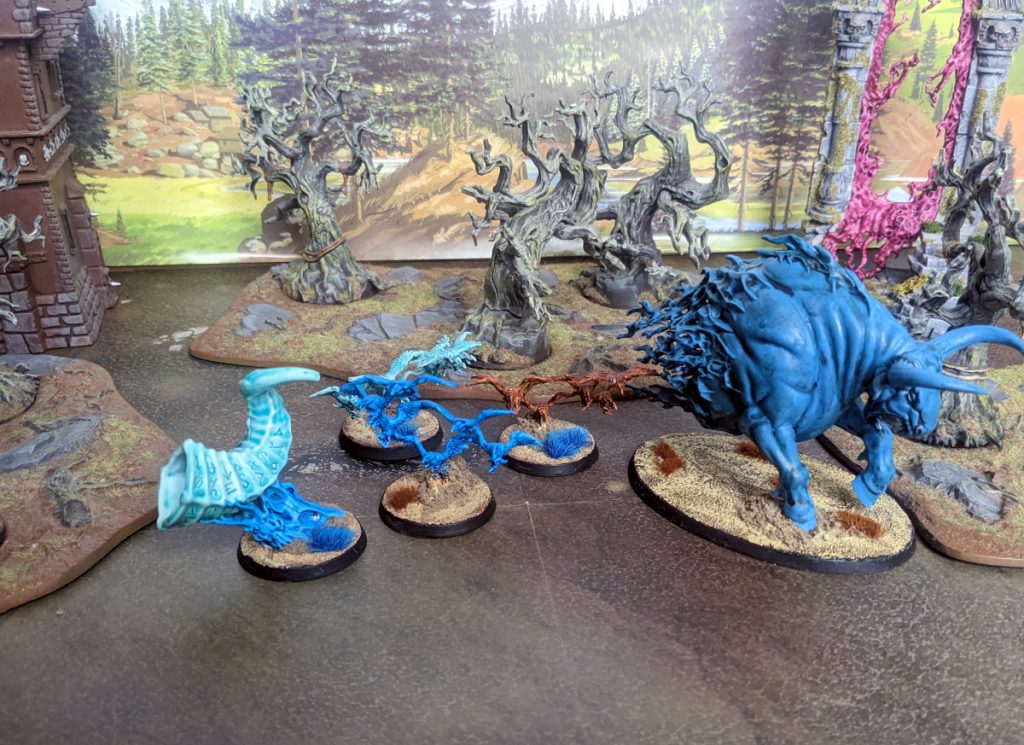
Endless Spells
Ravening Direflock
This spell is all about shutting down enemy commands. Rally and Inspiring Presence can’t be used within 6” of one of the three pieces of the spell (it used to be 12”). If an enemy model issues a command within 6” of the spell on a 5+ the command is not received and the command point is lost. We have ways to mess around with enemy commands in this book, so this adds to it. It no longer gets removed if enemies come near, which makes it much better.
Doomblast Dirgehorn
This is definitely a mid-range spell for me. When set up, it has a 6” range – non-BoC units within range subtract 1 from wound rolls. Each turn that goes up by 6”. It used to be 3” range and 3” increase and on hit rolls, so this is a welcome change. At only 30 points it seems like a really interesting spell to try out a few times. It could be used for area denial, objective taking, or obviously just making your goats more durable.
Wildfire Taurus
The OG activation wars bull, the Taurus hasn’t changed at all since last updated. It does D3 mortal wounds on a 2+ to enemy units and they strike-last. I used it quite a bit before, but I wonder how much utility we’ll get out of it when Gors can make units strike-last now. Obviously this one is more dependable once you get it on the field – it just automatically makes enemies strike-last instead of on a 3+.

Faction Terrain
Herdstone
The reason for the season, the Herdstone is still great and will still define BoC. Melee weapons used by BoC (battlefield wide) improve their rend by one from turn 2-3, and on turn 4 they improve to -2. There is no longer a rally benefit, but units have those built-in with their standards. It costs zero points so there is zero reason not to use it.
Conclusion
As a Beasts of Chaos player from back in WHFB, this Battletome really brings around a lot of what I wanted – we’re no longer a chaff faction that runs forward and hits stuff, and sometimes hits stuff better with some abilities – we’re a faction that has a lot of utility and tech that can make things so much more interesting. Some of my favorite models are better now, including Bestigors, Gors, and the Beastlord.
While the big monsters are questionable includes to me – I am definitely going to try them out a few times. I really like that my Tzaangors on Discs are still going to be a staple in my lists.
To be super clear, I wasn’t so much a fan of flooding the board with bodies and scoring points. I hate transporting that many models around, and I hate buying and painting that many minis just to set them up and take them off quickly. I feel like we have a lot more strategy now, layers that weren’t there previously. While we lost summoning, we are now the GOATs of ambush. Losing summoning means we likely need to bring fewer models with us to the game store. There is something to be said for that – not having to buy as many models, not having to transport them all.
I have a feeling it’ll take a bit for Beastlords to get the toolbox going but once they do I think they’ll really like this book. Shatter their walls and gore their flesh!
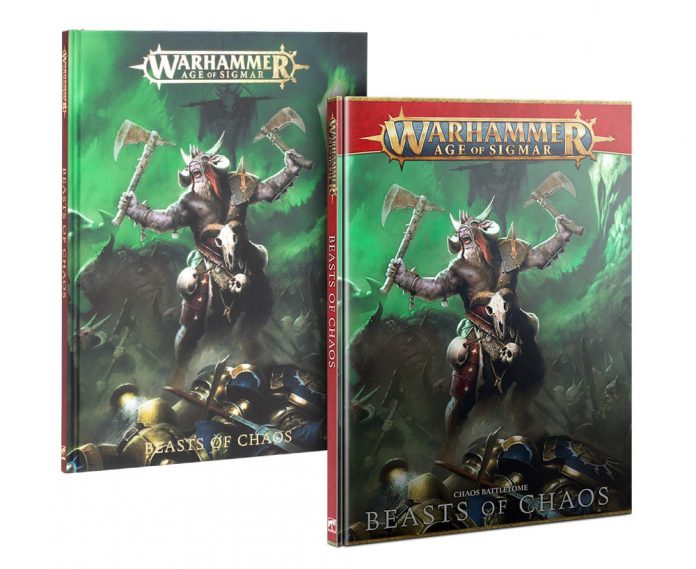


You must be logged in to post a comment.